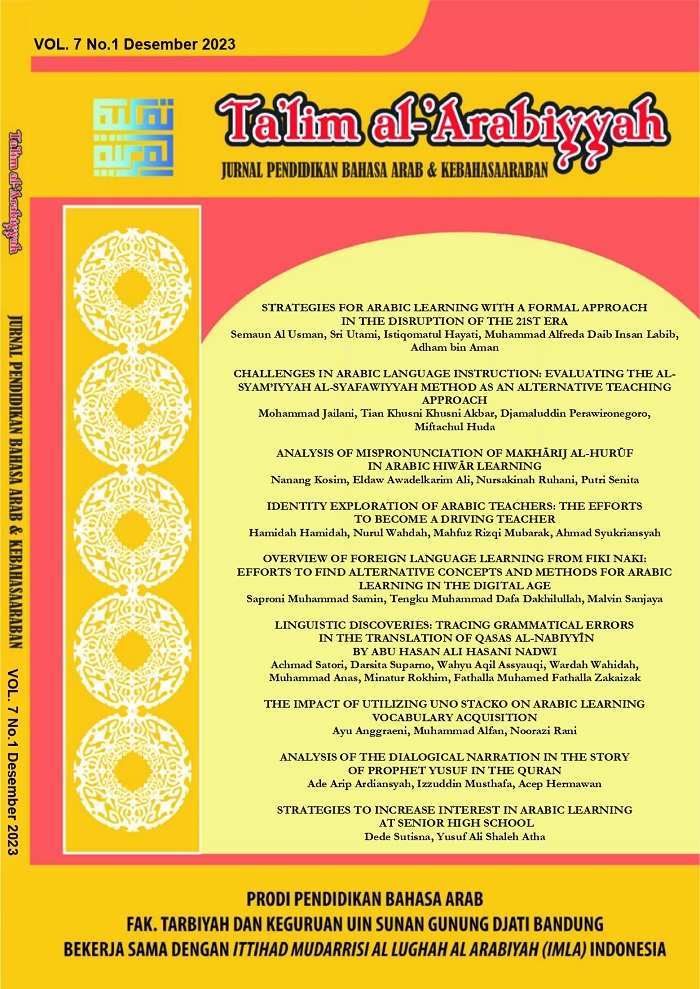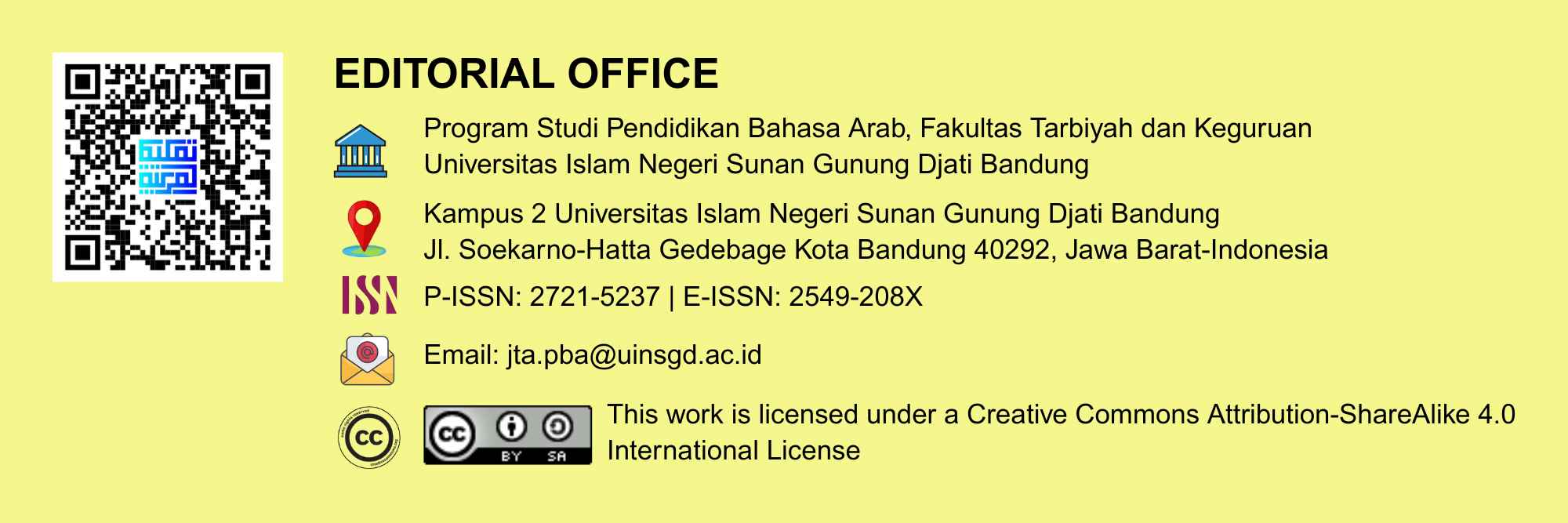Analysis of The Dialogical Narration in The Story of Prophet Yusuf in The Quran
DOI:
https://doi.org/10.15575/jpba.v7i2.25684Keywords:
Dialogical Narration, Story of Prophet Yusuf, Linguistic Analysis, Speech ActsAbstract
This study aims to analyze the narrative structure in the story of Prophet Yusuf in the Quran, focusing on its dialogical elements. This research uses a qualitative approach; the study employs narrative analysis to explore how conversations contribute to the construction of the overall story. The following steps and strategies will be used in this research: (1) Text Collection: (2) Text Analysis (3) Literature Review (4) Conceptual Framework (5) Comparative Analysis (6) Interpretation and Conclusion (7) References: All sources used in this research will be listed in the reference list, including Qur'anic verses, scholarly literature, and other sources. By deeply understanding the dialogic narrative elements, the study aims to reveal the significance of conversation, its role in character development, and its impact on critical themes in the narrative. Employing Austin's speech act framework, specifically emphasizing imperative speech acts, the analysis centers on 29 instances identified in verses (9, 10, 12, 15). Additionally, a subset of seven imperative sentence structures, found in verses (29, 47, 88, 101), is explored to deepen understanding, emphasizing the locution component. The main findings show that dialog in this story is not just a conversation but also plays a role in building conflict, revealing character, and conveying important messages. This dialogic narrative analysis can provide deeper insights into how the story of Prophet Yusuf is presented in the Qur'Än and how dialog becomes an essential element in religious narratives. This research is relevant to understanding religious literature and Islamic wisdom and can provide valuable insights into studying sacred texts; this study highlights the critical role of dialogic narrative in depicting the story of Prophet Yusuf and presents a deeper understanding of religious narrative in the Qur'Än. However, limitations include the exclusive focus on imperative speech acts, overlooking potential nuances of other speech act types, and a lack of contextual considerations. Recommendations for further research include a more in-depth exploration of the cultural and linguistic context in the dialog, hoping to provide further insights into how the Quran uses dialog elements to convey messages and moral values. In addition, it is suggested that this research can be used as a foundation to develop a dialogic narrative model that can be applied to daily life stories and provide a better understanding of communicative aspects in the Islamic literary tradition.
References
Ahmad, A. R., & Hashimi, M. B. (2016). The Language of Dialogue in Surah Yusuf: A Sociolinguistic Analysis. Journal of Linguistic and Literary Studies, 7(2), 111–127. https://doi.org/10.31436/jlls.v7i2.405
Akrom, M. (2014). Analisis Ketampanan Nabi Yusuf Dalam Perspektif Semiotika Al-Qur’an. ARABIYAT: Jurnal Pendidikan Bahasa Arab Dan Kebahasaaraban, 1(2), 223–236. https://doi.org/10.15408/a.v1i2.1141
Amril, D., & Hafizzullah, H. (2020). Figur Nabi Yusuf AS Bagi Kaum Milenial Dalam Menghadapi Era 4.0. Jurnal Ulunnuha, 9(1), 49–62. https://doi.org/10.15548/ju.v8i3.1182
Anggara, R. A., Asshiddiqii, S. H., Ridho, Muh. M. A., & Muhammad, H. N. (2023). Makna Al-Qamish Pada Kisah Nabi Yusuf dalam Al-Quran: (Kajian Tematik: Surat Yusuf). Al Muhafidz: Jurnal Ilmu Al-Qur’an Dan Tafsir, 3(1), 78–86. https://doi.org/10.57163/almuhafidz.v3i1.66
Asyifah, N. (2022). Relasi Makna Antonimi dalam Al-Qur’an Surah Yusuf. A Jamiy: Jurnal Bahasa Dan Sastra Arab, 11(2), 407–418. http://dx.doi.org/10.31314/ajamiy.11.2.407-418.2022
Aulia, Y. V. (2022). Mengungkap Makna “Abaqo†Nabi Yusuf dalam Al-Qur’an (Aplikasi Semiotika Roland Barthes Terhadap QS. As-Saffat: 140). Jurnal Semiotika-Q: Kajian Ilmu al-Quran Dan Tafsir, 2(1), 17–32. https://doi.org/10.19109/jsq.v2i1.11445
Darmawan, D. (2016). Analisa Kisah Yusuf dalam Alquran dengan Pendekatan Hermeneutika. Al-Bayan: Jurnal Studi Ilmu Al- Qur’an Dan Tafsir, 1(1), 8–16. https://doi.org/10.15575/al-bayan.v1i1.870
Dimyati, M. A. (2019). Asy-SyÄmil fÄ« BalÄgah al-Qur’Än. Lisan Arabi.
Fasieh, R., & Irwan, M. (2019). Analisis Unsur-Unsur Intrinsik pada Kisah Nabi Yusuf As dalam Al-Qur’an Melalui Pendekatan Kesusastraan Moderen. Jurnal Al-Ibrah, 8(1), 93–107. Retrieved from http://jurnal.umpar.ac.id/index.php/ibrah/article/view/23
Hanif, M. (2018). Kisah Nabi Yusuf Dalam Al-Qur’an; Kajian Stilistika Al-Qur’an Surah Yusuf. AL-AF’IDAH: Jurnal Pendidikan Bahasa Arab Dan Pengajarannya, 2(2), 1–27. https://doi.org/10.52266/al-afidah.v2i2.215
Hardiyanti, F., Abdussalam, A., & Sumarna, E. (2015). Nilai-Nilai Akhlak dalam Komunikasi Edukatif Ayah-Anak di dalam Al-Quran (Studi Tematis Terhadap Kisah Ä€zar-Nabi IbrÄhÄ«m, Nabi IbrÄhÄ«m-Nabi IsmÄ’il, Nabi Ya’qÅ«b-Nabi YÅ«suf). Tarbawy: Indonesian Journal of Islamic Education, 2(2), 123–136. https://doi.org/10.17509/t.v2i2.3449
Harimuddin S, M. (2022). Kisah Nabi Yusuf AS. sebagai Metode Pendidikan. Action Research Literate, 6(2), 87–93. https://doi.org/10.46799/arl.v6i2.122
Hoithun Marro Dinillah, M. S. A. (2023). Kisah Nabi Yusuf As Dan Zulaikha Dalam Surat Yusuf Ayat 22-35 (Analisis Semiotika Roland Barthes) [Skripsi, UIN KH Achmad Siddiq Jember]. Retrieved from http://digilib.uinkhas.ac.id/17951/
Ibnuansyah, R., Baihaqi, Y., & Shomad, B. A. (2022). Solusi Efektif Pencegahan Hawa Nafsu Pada Kisah Nabi Yusuf dalam Al-Qur’an. Ta’lim, 4(2), 1–15. https://doi.org/10.36269/tlm.v4i2.881
Ikhwan, I., & Sari, B. S. (2020). Representasi Palestina Dalam Kisah Nabi Yusuf Analisis Semiotik Puisi “Ana YÅ«sufu(n) YÄ Abī†Karya Mahmud Darwis. Metahumaniora, 9(2), 207-223. https://doi.org/10.24198/metahumaniora.v9i2.24895
Irwan, M. (2021). Makna Kontekstual Dialog Kisah Nabi Yusuf As Dalam Al-Qur’an. Jurnal Al-Ibrah, 10(2), 83–107. Retrieved from http://jurnal.umpar.ac.id/index.php/ibrah/article/view/1367
Istantiani, M., & Utami, R. R. (2021). Relevansi Tokoh Yusuf dengan Karakter Pemimpin Demokratis: Kajian Filologi Serat Yusuf. Kejawen, 1(2), 100–115. https://doi.org/10.21831/kejawen.v1i2.40379
Mahliatussikah, H. (2016). Analisis Kisah Nabi Yusuf Dalam Al-Quran Melalui Pendekatan Interdisipliner Psikologi Sastra. Arabi : Journal of Arabic Studies, 1(2), 75-89. https://doi.org/10.24865/ajas.v1i2.13
Matswah, A. (2018). Pendekatan Kritik Naratif A.H. Johns terhadap Narasi Dialog dalam Surah Yusuf. SUHUF, 11(1), 145–162. https://doi.org/10.22548/shf.v11i1.308
Maulana, A. (2020). Pengaplikasian Semiotika Dalam Kajian Islam (Studi Analisis Kisah Nabi Yusuf). Jurnal Indo-Islamika, 1(2), 197–207. https://doi.org/10.15408/idi.v1i2.16647
Najiah, S., & Yurisa, P. R. (2019). Kalam Insya’ Thalabi dalam Al-Quran Surat Yusuf (Studi Analisis Balaghah). 3, 510–528. Retrieved from http://prosiding.arab-um.com/index.php/semnasbama/article/viewFile/413/388
Norhidayati Rahmah, M. (2017). Model Komunikasi Interpersonal dalam Kisah Nabi Yusuf As. Al-Hiwar : Jurnal Ilmu Dan Teknik Dakwah, 4(6), 1–12. https://doi.org/10.18592/al-hiwar.v4i6.1212
Nurdin, A. (2019). Etika Pergaulan Remaja dalam Kisah Nabi Yusus As (Telaah Tafsir Tarbawi dalam Surat Yusuf Ayat 23-24). Andragogi: Jurnal Pendidikan Islam Dan Manajemen Pendidikan Islam, 1(3), 490–510. https://doi.org/10.36671/andragogi.v1i3.69
Oktavia, Y., Wardani, R. W., Muassomah, M., & Muzakki, A. (2023). Tasybih dalam Alquran: Analisis Tasybih pada Segi Rukun dalam Surat Yusuf. Hijai-Journal on Arabic Language and Literature, 6(1), 46–59. https://doi.org/10.15575/hijai.v6i1.18710
Pratama, O. P. (2017a). Kesantunan Berbahasa: Prosa Bografi Kisah Nabi Yusuf Dalam Al-Qur’an [Tesis]. UIN Syarif Hidayatullah.
Pratama, O. P. (2017b). Tindak Tutur Santun Dalam Kisah Nabi Yusuf. Arabiyat : Jurnal Pendidikan Bahasa Arab Dan Kebahasaaraban, 4(2), 227–254. https://doi.org/10.15408/a.v4i2.6352
Purnama, R. F., & Sopyan, I. (2021). Kisah Nabi Yusuf dalam Al-Qur’an dan Alkitab. Jurnal Online Studi Al-Qur An, 17(02), 265–285. https://doi.org/10.21009/JSQ.017.2.06
Rahmah, S. A. Y. (2015). Riwayat Nabi Yusuf As Putra Nabi Yakub As Di Negeri Kanaan: Kritik Teks Dan Tinjauan Kandungan Isi [Skripsi, Universitas Pendidikan Indonesia]. Retrieved from http://repository.upi.edu/18934/
Sholahuddin, M. Z. (2021). Menyingkap Tabir Surat Yusuf (Dilengkapi dengan Kajian Lughah, Nahwu, Balaghah, Sejarah, Akidah, Fikih, Ushul Fiqih, Tasawuf, dan lain lain). Bariclana MQ Press.
Suhendra, F. (2021). Kisah Dramatisasi Saudara-Saudara Nabi Yusuf As dalam Al-Qur`an dengan Pendekatan Teori Konspirasi. Semiotika-Q: Jurnal Semiotika Al-Qur’an, 1(1), 37–48. https://doi.org/10.19109/jsq.v0i0.8986
Thobroni, A. Y. (2016). Pola Pendidikan Nabi Ya’qub A.S. Dalam Mendidik Nabi Yusuf A.S. Perspektif Al-Qur’an. Jurnal Pendidikan Agama Islam (Journal of Islamic Education Studies), 2(2), 219–232. https://doi.org/10.15642/pai.2014.2.2.219-232
Yusuf, M., & Solehuddin, S. (2023). Kajian Semiotika Jacobson terhadap Dialog Nabi Ya’qub dan Nabi Yusuf dalam Surat Yusuf. Mashadiruna Jurnal Ilmu Al-Qur’an Dan Tafsir, 2(1), 31–40. https://doi.org/10.15575/mjiat.v2i1.23779
Zakaria, K., & Nordin, M. Z. F. (2021). Bahasa dan Kuasa: Analisis Wacana Bahasa Perundingan Nabi Yusuf AS dengan Saudara-Saudara Baginda. Al-Irsyad: Journal of Islamic and Contemporary Issues, 6(1), 662–670. https://doi.org/10.53840/alirsyad.v6i1.194
Zulhelmi, A. (2021). Bahasa Al-Qur’an di dalam Surat Yusuf Mengatasi Kemerosotan Akhlak Pemuda di Zaman Modern: Studi Analisis Menggunakan Metode Kisah Teladan Nabi Yusuf. Proceedings ICIS 2021, 1, 191–199. Retrieved from https://jurnal.ar-raniry.ac.id/index.php/icis/article/view/12667
Downloads
Published
How to Cite
Issue
Section
Citation Check
License
Authors who publish in Ta'lim al-'Arabiyyah: Jurnal Pendidikan Bahasa Arab dan Kebahasaaraban agree to the following terms:
- Authors retain copyright and grant the journal right of first publication with the work simultaneously licensed under a Creative Commons Attribution-ShareAlike 4.0 International (CC BY-SA 4.0) License that allows others to share the work with an acknowledgment of the work's authorship and initial publication in this journal.
- Authors are able to enter into separate, additional contractual arrangements for the non-exclusive distribution of the journal's published version of the work (e.g., post it to an institutional repository or publish it in a book), with an acknowledgment of its initial publication in this journal.
- Authors are permitted and encouraged to post their work online (e.g., in institutional repositories or on their website) prior to and during the submission process, as it can lead to productive exchanges, as well as earlier and greater citation of published work (See The Effect of Open Access).
![]()
Ta'lim al-'Arabiyyah: Jurnal Pendidikan Bahasa Arab dan Kebahasaaraban is licensed under a Creative Commons Attribution-ShareAlike 4.0 International License.
Based on a work at https://journal.uinsgd.ac.id/index.php/Talim








